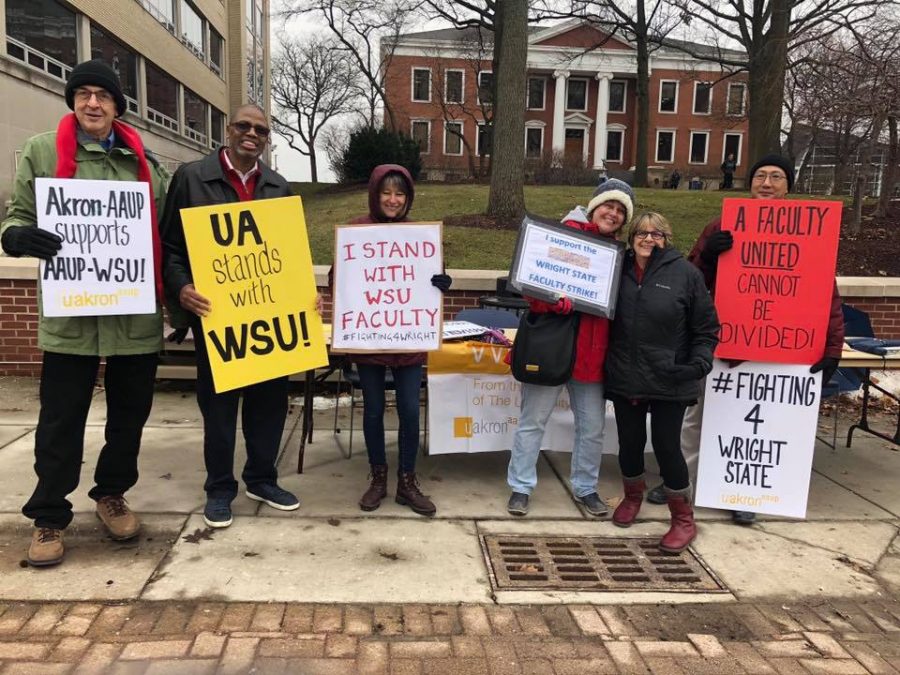UA, KSU Faculty Hold Solidarity Picket Line to Support WSU Strike
The Presidents of American Association of University Professors chapters at UA and KSU held the picket line for other faculty and students to show support for WSU.
Faculty members from both UA and KSU standing in the picket line while holding signs of support for WSU faculty.
February 6, 2019
Members of the American Association of University Professors from The University of Akron and Kent State University held a solidarity picket on the UA campus in support of the faculty at Wright State University on Feb. 5.
The picket took place across from Bierce Library on Buchtel Mall, where UA and KSU faculty members wore red, held signs and overall informed people of the striking and negotiations occurring at WSU.
Dr. Pamela Schulze, President of the Akron-AAUP, along with Dr. Melissa Zullo, President of the AAUP-KSU, stood in the picket line at WSU on Feb. 4 and realized many faculty members are unable to travel as far.

Faculty members standing in Buchtel commons with signs to show support to the WSU faculty on strike.
Both Schulze and Zullo decided to bring their union chapters together and hold a picket line at UA to provide faculty members and students with a way to show support and encouragement of those at WSU.
“That way, everyone can do something,” Schulze said. “Even if it’s only stop by for a few, eat a cupcake, pose for a picture and then go. This is an important issue for everybody.”
Faculty at WSU originally began their strike against the administration and Board of Trustees on Jan. 22 after two years of failed negotiations for contract agreements, according to an article from The Chronicle of Higher Education.
These negotiations came from the university going from $162 million to around $31 million in their total reserves and other mismanagement from the administration.
“They’ve had a lot of financial problems, which was a result of mismanagement by the administration over the last several years and that has caused financial problems for Wright State. However, they don’t need to take that out on the faculty,” Zullo said.
While the faculty union hoped contract negotiations would lead to fair labor and healthcare coverage, WSU focused on reaching an agreement that would aid in long-term university financial stability, according to the Dayton Daily News.
“The 17 percent of the budget that’s allocated to full-time faculty: that’s not where you are gonna find your savings. That’s not where you should find your savings,” Schulze said.
Zullo said the faculty union is not negotiating for things that are “outrageous” and that these negotiations are also impacting WSU students who deserve well respected, well-trained faculty.
According to the Dayton Daily News, WSU academic departments began telling students that some classes, especially “specialized” classes, were not able to be covered and would, in turn, be canceled.
Debt for college students is continuing to grow and they should at least get what they are paying for, Schulze said. One of the things that students are paying for is full-time faculty.
Nonetheless, several students at WSU are fighting alongside the faculty through various methods of protests; such as joining the picket line or a sit-in outside of the President’s office.

One student from WSU shared their experiences due to the WSU faculty strike and administration opposition on Twitter.
According to the Dayton Daily News, 17 students participated in the sit-in to represent how the WSU faculty comprises only 17 percent of the university’s overall budget.
Schulze said these issues at WSU are important for everyone to pay attention to as it not only impacts faculty unions across the nation but also could set a precedent for similar issues in the future.
“This is an issue that everybody ought to be watching and really concerned about because if we allow any group of workers to be treated this way, it is really wrong and a frightening message to send to society,” Schulze said.
There are ways people can show support to the WSU faculty if they are unable to stand in the picket line or participate in other forms of protest.

Faculty members were passing out pins and pens to people passing by during the picket line, while also answering questions about the WSU faculty strike.
A petition is available online for people to sign here.
Schulze said people can also write letters to the President of WSU and even someone at the state level because of how far these issues have gone.
Lastly, people are encouraged to like and share the WSU faculty union social media posts in order to help spread awareness of the issues at the university. Find them on Facebook and on Twitter.
Overall, Schulze and Zullo were inspired by the actions the WSU faculty union has taken so far to combat the administration’s decisions and reach a fair contract negotiation.
“I am just so inspired by the work they’re doing on that picket line,” Schulze said. “The positive takeaway is collective action can work. When people come together, they can do amazing things.”














Anonymous • Feb 10, 2019 at 10:19 PM
Maybe this paper should do some investigative journalism and find out how low student interest in journalism really is.